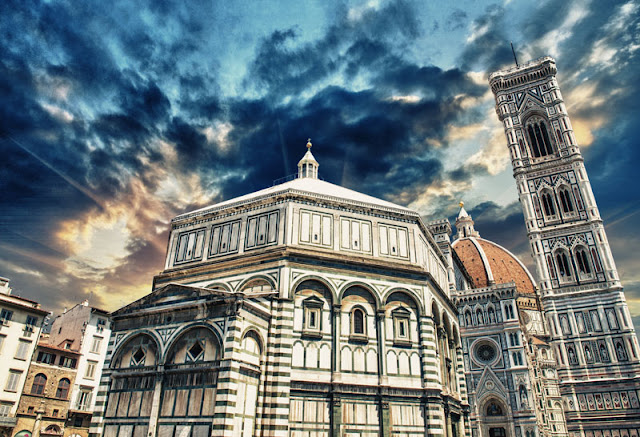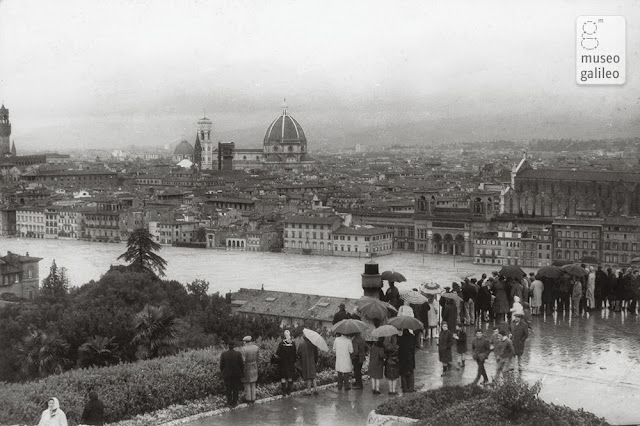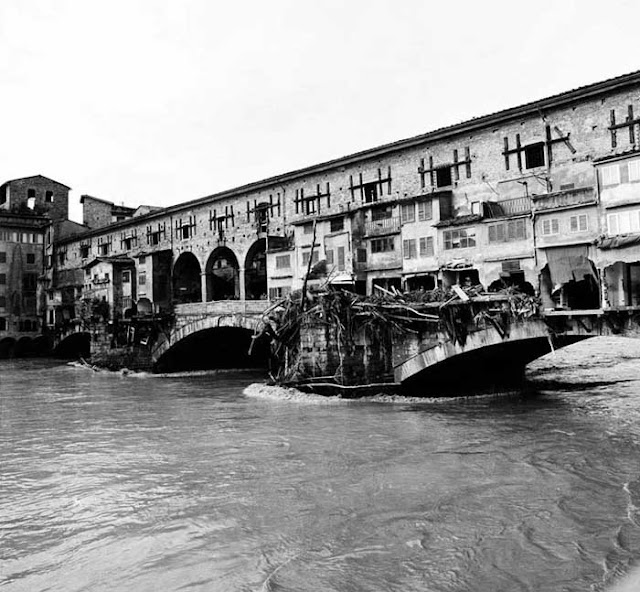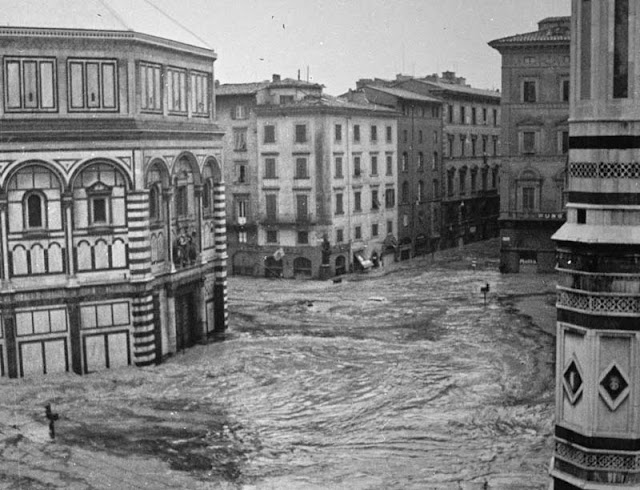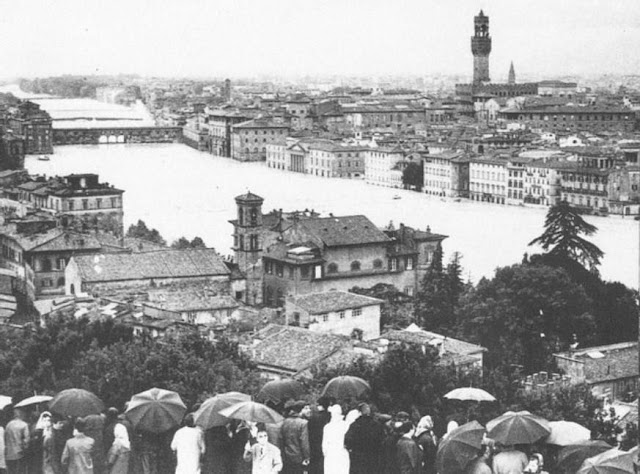A few months back, during a somewhat challenging week at work, an Italian colleague introduced me to one of his country’s best-loved idioms: piove sempre sul bagnato. Roughly translating as “it always rains where it’s already wet”, it represents one of the many cultural convergences between Anglophone and Latin countries – a helpless, if not at least humorous, acknowledgement of Sod’s law.
In English (or at least in England, where wet weather is an area of national expertise), we convey the same meaning with the saying “when it rains it pours”. In whatever language, you can imagine that such feeling was widespread around the city of Florence on 4 November 1966. And that many were perhaps wishing the rain had instead fallen in Spain, and mainly on the plain.
The lead-up to the flood had been inauspicious enough. The 48-hours spanning 2 and 3 November saw an absolute downpour – around a third of Florence’s annual rainfall – only adding to the recently melted snow saturating the River Arno. Any Florentine looking out over the river might have feared the worst. And they had every reason to: the Arno was prone to flooding, having done so 56 times since records began in 1177. And by some strange coincidence, two of the worst floods – in 1333 and 1844 – had occurred on 4 November.
By 3 November, the Levane and La Penna dams upstream at Valdarno had become dangerously inundated with water. At around 4 a.m. the next morning, in an effort to keep the dams from bursting, officials decided to release some of the excess water downstream towards Florence. In doing so, they discharged a huge mass – some 2,000 cubic metres per second – that thundered towards the city’s outskirts at a rate of almost 40 mph.
By 5 a.m. the Arno had burst its banks, spilling oil slick, filthy water over onto both sides of the city. And by 9:45 a.m. Florence’s iconic Cathedral was left standing in up to 1.8 metres. Residents of the city would spend the remainder of the day looking on hopelessly as this flood of biblical proportions ravished their city. Only at around 8 p.m. did the water begin to recede, leaving a physical legacy of 600,000 tons of thick mud.
The cultural cost to the city was considerable. Although different depths of water affected different districts – as this topographical map shows – Florence’s cultural patrimony was spread out in such a way that nowhere escaped unaffected. Between 3 and 4 million books and manuscripts were damaged, along with some 14,000 movable works of art. But the human cost was worse: the flood left 20,000 families homeless, forced 6,000 businesses out of business, and claimed 32 lives.
A torrent of condemnation was immediately poured on the government for not having put more preventative measures in place. In reality, while extra measures could have been taken, there was little that could have been done to avert the disaster. But there was a need to channel the blame for such an awful flood, and the government made an easy target. Or, as another rain-related Italian idiom goes: piove, governo ladro! – “it’s raining, damned government”, or, less literally, “whatever happens, it’s the governments fault”.
But the story of the 1966 flood isn’t one of blame; it’s one of cooperation. Responding to Florence’s desperate plight, hundreds of Angeli del Fango(“Mud Angels”) descended on the city within days. These volunteers – both Italian and international – took up the drudgery of rebuilding the city and saving whatever they could. And others, both with and without a connection to the city, played their part as best they could: within a month of the disaster, Florence-born director Franco Zeffirelli released his fund-raising film “Per Firenze” (or “Florence: Days of Destruction”, in English); well worth watching for Richard Burton’s Italian narration alone.
 |
| Volunteers – Mud Angels |
Last year saw the celebration, if that’s the right word, of the flood’s 50th anniversary. Across the city, there were photographic exhibitions, commemorative events, and, at the pinnacle, the reinstallation of Giorgio Vasari’s painstakingly restored “Last Supper” (1546) in the Basilica of Santa Croce. In fact, over the weekend of the anniversary, the Arno’s waters again began to rise to alarming heights. Though whether this was down to chance occurrence or to the Florentine’s strong commitment to commemorative accuracy remains to be decided…
There are two sides to the flood of 1966: the collective and the personal. Last year, the city played host to commemorating the collective: the rebuilding of the city, the restoration of its artworks, and the international efforts of the Mud Angels. But talk to any Florentine who lived through the flood and they’ll give you another, more personal side. I’ve caught up with a friend and former student, Raffaello Santi. A Florentine born and bred, Raffaello is now in his early seventies, and remembers the flood vividly.
He tells me that when the flood first hit, he – fortunately like many others – had been out of town. Taking advantage of a public holiday, he’d been hunting wild boar with friends in San Benedetto Val di Sambro, a small village in Italy’s regional culinary capital, Emilia Romagna. He heard of what had happened through his two sisters, who were living in Florence.
He only made it back the next day – the long journey made even longer by the fact that many of the roads around Florence had been either closed or destroyed. He went first to check on his pregnant sister who was living on the Via Masaccio: a road still a good half a mile north of the river that had nonetheless been submerged in two to three metres of water. After that, he made his way into the city centre.
The Ponte Vecchio
The Ponte Vecchio (now on its third incarnation, the previous two having been destroyed by floods in 1117 and 1333) was wrecked. A huge tree that had washed up against the side of the bridge lay suspended across it – seemingly floating in mid air, it was held in place only by its entanglement with other debris. Others had penetrated the shops lining the bridge and were sticking out the other end. But Raffaello more vividly remembers a petrol tanker that had been washed downstream and left repeatedly smashing against, and ultimately through, the centre of the bridge. It had caused tremendous damage, but by easing the water pressure, it had in all likelihood also saved the bridge.
The Duomo and Baptistery
In the Baptistery that stands before the Duomo, the water reached a height of 2.4 metres. But it wasn’t so much the height as the force that did the damage. It’s well known that five of the panels of Ghiberti’s Doors of Paradise were ripped off their Baptistery doors, fortunately to be found again later. It’s less well known, Raffaello tells me, that many chairs from Bar Scudieri, one of the oldest locals still operating on the piazza, were found washed inside the interior cathedral, ushered in by the floodwaters and left to mingle among the pews and altars. Look to the right of the Scudieri’s entrance today, and you can see a plaque marking the height the water reached.
Santa Croce
The worst of the flooding was in the Santa Croce area where the water reached heights of 6.7 metres. The damage caused to the Franciscan Basilica was terrible. Not only were its illustrious inhabitants – Michelangelo, Machiavelli, Galileo, and Ghiberti – submerged in their tombs for over 12 hours, but many important artworks were either badly damaged or completely destroyed. Cimabue’s “Crucifix” – only restored and reinstalled in the site’s museum in 1976 – became a fitting international symbol of Florence’s suffering. Vasari’s “Last Supper”, on the other hand, was so badly damaged that experts had no other choice than to wait for the technology to be invented to save it.
 |
| Flooding plates in Piazza Santa Croce |
The marks left by the flood are still visible in Santa Croce’s piazza. Facing away from the church, if you look just below the street sign in the far right hand corner of the piazza you’ll see two plaques. The lower one marks the Arno’s waterline during the flood of 1557. The higher one reads: Il IV Novembre 1966 l’acqua dell’Arno arrivò a quest’altezza (“On 4 November 1966 the Arno’s water reached this height”). Staggeringly, it’s just short of the first-floor windows.
Plaques like these are, in fact, all over the city. It just takes a sharp eye (and a cricked neck) to find them. We’ve already mentioned the one on Bar Scudieri near the Duomo, but they can also be found on the Via della Vigna, the Via San Remigio (where 1333 and 1966 are marked) and the Via Isola delle Stinche – once home to one of the city’s most feared prisons.
And it was in these such side streets away from the centre, Raffaello tells me, that one discovery above all that baffled the Florentines. An enormous tree trunk, some 30 metres in length, was found washed up in the Via Laura. And nobody could work out how it got there.
For a start, it was too wide in diameter to be dislodged by machine, never mind by hand. As well as this, the area around the Via Laura is not only quite some distance inland (well over half a mile away), but it’s in the middle of a labyrinth of narrow, winding, pedestrianized streets. In the end, the tree had to be sawn in half before being removed, leaving onlookers none-the-wiser as to how it could have rooted itself there in the first place.
Outside the City
 |
| Venice during the flood on 4th november 1966 |
Florence may have received the brunt of attention from the world’s media. But it didn’t suffer the worst of the flooding that year. Out in the country, the floodwater stranded people in their homes and on their roofs, leaving them reliant on volunteers in dinghies or improvised boats below for vital resources. Maremma – the once malaria-infested Wild West of Tuscany now turned coastal jewel in the region’s crown – was the worst affected area in the region, particularly its capital Grosseto.
And outside Tuscany, Venice fared much worse. Heavy rainfall, combined with a cyclone over the city causing 60 mph winds, increased sea levels by almost two metres; worsening Venice’s already precarious situation in the middle of a lagoon. The Doge’s Palace, in St. Mark’s square, was submerged in 194 centimetres of water and the city was left completely cut of for 24 hours.
“A City of Endurance”
When, in 1956, the American novelist Mary McCarthy described Florence as “a city of endurance, a city of stone”, she couldn’t have imagined what the city and its inhabitants would have to face ten years later. The flood was a civic and a national catastrophe. It destroyed property, wrecked livelihoods, and worst of all claimed lives.
But there was a silver lining around the storm clouds of November 1966. Necessity brought about innovations in the field of preservation and restoration, and saw the best side of international cooperation for the preservation of artistic heritage. And despite what the Florentines had endured, they never let the flood completely dampen their spirits, proving McCarthy’s dictum right.
“The floods are part of what make Florentines who they are,” writes Robert Clark, author of “Dark Water: Art, Disaster, and Redemption in Florence”. Since the city’s origins, they’ve found expression in art, in literature, and in Florentine sayings still used today: Arno non cresce se Sieve non mesce(the Arno won’t grow if Sieve won’t add to it); Quando Monte Morello ce l’ha il capello, Fiorentino piglia l’ombrello(when Mt. Morello is wearing its hat, Florence needs its umbrella).
But one anecdote Raffaello tells me encapsulates the Florentine spirit in the flood’s aftermath more than any other. While helping the desperately disheartened artisan community of San Frediano save what they could from their flooded workshops, he recalls an exchange that took place between a shopkeeper called Moreno and one of his neighbours. Noticing that Moreno was just calmly sitting around in the mud soaked street, his neighbour asked him whether at some point he intended to get to work clearing out his shop. “I trade in antiques!” Moreno replied, “and they’re only going to get more antique the longer they stay down there.”
Written by: Alex Meddings
If you liked this article, read also: “IN THE FOOTSTEPS OF THE MEDICI: MURDER AND INTRIGUE AT THE HEART OF THE RENAISSANCE“

